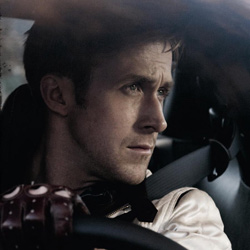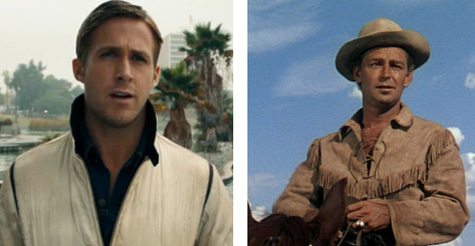
One thing that has become clear to me upon repeated viewings is how much Drive resembles a . . . Western. And in particular how much it resembles George Stevens’s 1953 classic Shane. That movie, you may recall, stars Alan Ladd as a tight-lipped drifter named Shane who wanders into a dispute between a small group of homesteaders and a ruthless rancher. Shane becomes close to the Starrett family, father Joe (Van Heflin), wife Marian, and young Joey (Brandon De Wilde). When the ranchers, headed by crusty old Emile Meyer, employ a black-clad gunslinger named Wilson (Jack Palance in a supremely evil performance) to run off or kill the homesteaders, Shane straps on his gun and rides into town to settle things once and for all.
There are some surface similarities between this plot and Drive because Drive also concerns a silent loner who becomes involved with a small family. When Driver (Ryan Gosling) befriends Irene (Carey Mulligan) and her son Benicio (Kaden Leos), he is drawn into the world of Irene’s ex-con husband Standard (Oscar Issac) who is indebted to a group of gangsters. After a heist goes wrong and people start dying, Driver must resort to violence to, well, settle things once and for all.
As I said, these are surface similarities, but I’m not trying to draw a direct comparison in terms of plot. Drive clearly has many influences, from James Sallis’s poetic original novel to the music of REO Speedwagon. What I find fascinating, however, is the way Drive seems to share the same emotional core as Shane.

Both films are about unconsummated passion and unspoken love and the way these feelings are channeled into acts of violence. Shane has many fine attributes and chief among them is the quiet way it develops the love story at its center. Shane and Marian never kiss, never speak of their love for each other. Instead their passion plays out in looks, in the space between words. It’s a romance between adults, between two people who know these feelings can’t go anywhere. One person who notices, however, is Joe. In a late scene, as he prepares to ride off to town to face certain death (a journey, it turns out, that Shane will take for him) Joe tells his wife in so many words that if he dies, she is free to marry Shane. It’s the most tender scene in the film because it is about a man who loves a woman so much he’s willing to see her be happy with another man.
Of course, Shane loves her so much he’s unwilling to see Joe go into town and get himself killed. Instead, he puts on his buckskin and six-shooter and rides off to kick ass. The sublimation of sexual tension into male-on-male violence is a trope of the Western, of course, but it reaches its zenith in Shane. Because Shane can’t bed the other guy’s wife, he does the next best thing and rides into town and kills everybody.
Like Shane, Drive is notable for its odd mix of tones. Refn’s film contains moments of great tenderness. Consider the shot of Driver carrying a sleeping Benicio to bed while Irene watches, her eyes telling you all you need to know about this woman’s hopes for this man and this little boy. In fact, Driver and Irene spend most of the film communicating with their eyes. Since Gosling and Mulligan are two of our best and most expressive actors (Carey Mulligan has the best smile in movies right now), the film can allow its center to be calm and silent. The film is also, on the other hand, an ass-kicking bonanza in its final forty-five minutes. Driver and Irene share a single kiss, in an elevator with a hired assassin looking on, and then Driver smashes the guy’s head to pieces.
Refn has said that he purposely positioned the film’s moment of greatest tenderness with its moment of most savage violence. Some viewers will doubtless think this juxtaposition goes way too far over the top, but this marriage of love and bloodshed underlies roughly half of all the action movies ever made. Odd as if may seem to say, cinema has always used violence as an expression of the frightening fragility of masculine emotions. The more fragile the emotions the man feels for the woman, the more violently he will treat the man who threatens her.
Both films position their hero as a silent loner who becomes the protector of a married woman and a small boy. Unable to consummate the relationship with the woman, the hero attempts to protect her husband instead. In the end, he expresses the depth of his love in a violent showdown with a superior force of evil men. Wounded, he rides off into the horizon to an uncertain future, possibly even to his own death.
That, my friends, is a damn love story.

PS: DRIVE author James Sallis has written a sequel to his novel called DRIVEN. I haven’t read it yet, but I hope they don’t do a sequel to this film. Sallis is a wonderful writer, and his first book is different from the movie, so I’m not passing any kind of judgment on his sequel. But the movie DRIVE feels complete as is. NO need for SHANE PART 2.
Great post Jake. I haven’t seen either of these movies and now they are on my Netflix list.
I’m exstatic that someone noticed the same thing. At the moment when he left at the end it just hit me. After that I started noticing all the other similarities.
I’ve been thinking a lot about Shane, lately. That Shane is ultimately a love story. And the only way the hero could express his love — and I think there were many types of love involved, including love for a woman, love of the land, parental love, and love for a friend — was to betray himself.
Thanks for this post.
I haven’t seen this “Driver” film, or read these books, but of course I have seen the film “Shane”. However now I must go back and watch it again as it has been so long ago since I have seen it. So many films coming out it is hard to keep up with them, and so many of them hold no promise of interesting me whatsoever. I usually make the deal with myself that if there is a book or books that come first and that are well worth reading, then I will read the book/s first, or all along, because I want to have the experience of the original product, if that is the case. Then, to compare the film/s against the book/s. Ryan Gosling probably is perfectly cast in “Drive”. I can visualize the comparisons made here btw these films. Looking forward to seeing it. ~ But, does this writer clone himself, or just what, exactly? Is time travel involved? Does he frequently “just check in to see what condition his condition is in”? on other simultaneous planes of (his) existence to ensure that his other selves or some of them, at least, are on the same page as concerns the whole *creative process*, churning out the art, writing, films, music, etcetera, etcetera, the whirlwind world tour…blah blah blah….wind surfing in hawaii with larry page….climbing mount everest….dropping in at mcmurdo….visiting the titanic w/Viking/ another jim….taking the space shuttle out for a spin….finally remembering to get around to visiting with his approx. but who’s countin’? like 872 wives and 3,469 +++ and growing harem of hmmm…well….variety is old spice! ‘K! Bye!
I also made this connection mid way through the movie. It was the silence of the “driver” that reminded be of Shane. Always cool, calm and collected, but still a bad ass